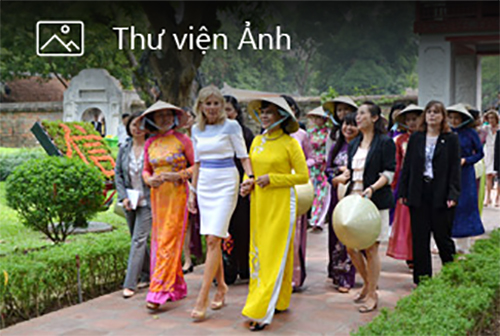HISTORY OF CONFUCIAN EXAMINATIONS IN VIET NAM
The history of Vietnamese Confucian examinations began with Tam Truong (three rounds) an examination to select Minh Kinh Bac Hoc (Bright Learned Men) which was held in 1075 during the reign of King Ly Thanh Tong. Tam Truong examinations were continuously organized in 1086, 1152, 1165, 1185 and 1193 during the Ly dynasty to seek talented men who could consolidate the apparatus of government. From 1195, the Ly dynasty held examinations covering the three doctrines (Confucianism, Buddhism and Taoism). Examinations covering these three doctrines were held until 1247 and were no longer organized since the reign of King Tran Thai Tong.
Under the Tran dynasty (1225-1400), the examination systems developed, examinations were held regularly, the rules and regulations were clearer. From 1232, the Tran dynasty organized the Thai hoc sinh examination to select De nhat giap (first class laureates), De nhi giap (second class laureates) and De tam giap (third class laureates). In 1247, the three titles Trang Nguyen (the first title), Bang Nhan (the second title) and Tham Hoa (the third title) were set for three persons who were first class laureates. In 1374, the royal examination was held in the imperial palace to recruit Tien si (doctoral laureates) instead of the Thai hoc sinh title. In 1396, King Tran Thuan Tong set out the first rules and regulations for the Huong (regional) examination to select the Cu nhan (bachelor). The rule of organizing the Huong examination every seven years was set, the Huong examination would be held before the Hoi (National) examination in the following year in the Capital. The Hoi examination began under the Tran dynasty.
During the short time of 7 existence years (1400-1407), the Ho dynasty paid attention to the national education and still continued following the examination rules of the Tran dynasty, but the regulations changes, examinations are held once every three years. In 1400, the Ho dynasty held the Thai hoc sinh examination. In 1404, procedures to select talented men were made: if the Huong examination were organized in the 8th lunar month of this year, then, the Hoi examination would be held in the 8th lunar month of the following year, successful candidates would become Thai hoc sinh.
During the Le So dynasty, examinations flourished and reached their highest level in the history of Vietnam examinations. In 1434, King Le Thai Tong issued an edict to fix the rules and regulations of the Huong and Hoi examinations and regulated that examinations were to be organized every three years.
In order to sit for the Huong examination, Confucian students had to pass a qualifying test held in their localities to eleminate those candidates who were not capable or virtuous enough. The Huong examination consisted of 4 rounds: The first round asked about the content of Confucian classics; The second round required candidates to write administrative documents such as King’s edicts, proclamations, petitions, letters to the Kings; The third round asked candidates to compose poems and odes; The fourth round required them to write essays. If the candidates were able to pass the first round they were qualified to sit for the next round. Huong examinations were usually organized in a spacious empty field such as a flat sandy site along a river side or in a rice field after the harvest. The examination field was surrounded with fences and some cottages were built in the centre for marking examination papers. Successful candidates of Huong examinations were called Huong cong and were allowed to sit for the Hoi examination.
The procedure and content of Hoi examinations were the same as those of the Huong examination, but at a higher level. Those candidates who were able to pass the fourth round of the Hoi examinations were qualified to attend the Dinh (royal) examination. The winner of the Hoi examination was called Hoi nguyen. The field of the Hoi examination was similar to that of the Huong examination.
The Dinh examination was organized at the royal court. Candidates were asked to write an essay on a topic given by the King about the methods of governing the State, the use of talented men, etc. The Dinh examination was for high-low ranking. The winner of the Dinh examination was called Dinh nguyen. According to the rules of the Le dynasty, the doctoral laureates were normally classified into three classes:
- The first class included a maximum of three persons (Tam khoi), the first title was Trang nguyen; the second was Bang nhan; the third one was Tham hoa.
- The second class laureates were called Hoang Giap (official doctoral laureates)
- The third class laureates became Tien si (doctoral laureates)
However, some examinations were able to recruit only 3 laureates (the examination held in 1592) and some were able to select as many as 62 laureates (the examination in 1478), so not all the titles were given after every examination and it was not always the fact that the first winner (so called Dinh nguyen) of the Dinh examination would be awarded the title of Trang nguyen. There were only 46 doctoral laureates who were awarded the title of Trang nguyen in the history of the Vietnam examination.
Examinations for Confucian students were organized all over the country, regardless of the school at which they studied, their age, social status or the number of examinations they attempted. As a result, some Hoi examinations were attended by as many as 6000 candidates, including those serving as civil mandarins and some were able to pass the examination while they were quite young, when another was able to become the winner of the examinations at the age of 68 (e.g. Quach Dong Dan passed the examination in 1634 when he was 68 years old). Yet, children of singers or entertainers, criminals or unvirtuous people or those who were in mourning, were not allowed to attend the examinations.
The Mac, Le Trung hung dynasties continued the rules and procedures of the Le So dynasty for the examination.
The Nguyen dynasty settled the capital in Hue. In 1807, the Huong examination was officially held, at the same time, the holding of the Huong examination was regulated to be held every three years during the years of Ty, Ngo, Mao, Dau and to organize the Hoi examination every three years, in the years of Thin,Tuat, Suu and Mui. The Huong Examinations fields were organized in many localities for candidates in one province or for those who were from other provinces, such as examination fields in Hanoi, Nam Dinh, Thanh Hoa, Nghe An, Thua Thien, Gia Dinh, An Giang. The Hoi and Dinh examinations were held in the capital of Hue. The Nguyen dynasty did not select Trang nguyen, but Pho bang which is under Tien si.
The history of Confucian examinations in Vietnam began in 1075 and ended in 1919, 183 major examinations were held, 2898 laureates were selected, including Trang nguyen, Bang nhan, Tham hoa, Hoang giap, Tien si and Pho bang.














 Guide to finding the way
Guide to finding the way
